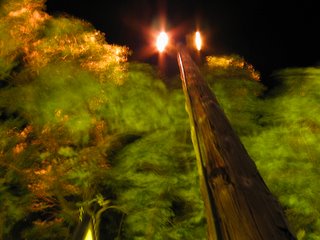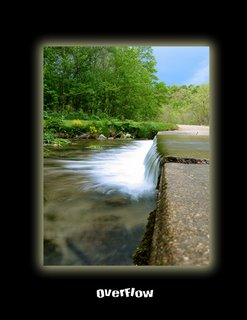This next portion is dedicated to my favorite part of photography. With out it, nothing would be able to exist except maybe a few cockroaches. I am talking about light and lighting. A photographer has a power means of expression with this constant source of energy. Whether you are using the sun, natural light, a flash, studio lighting, environmental lighting (ambient accent lighting from a near by source,) or even a flashlight; lighting and photography can change the way you view life as we see it everyday.
The photographer should always be aware of any light source they use, the fact of the matter is light can make or break your conceived view of whatever subject is being photographed. Whether it is intentional lighting that may cause shadows to the illumination of a florescent light or the sun peaking across your subject from a distance.
I recently discovered a new way to look at a night photography using streetlights or any other source of light that allows me to hold my shutter open and record a great balance of light with the subject. Now that doesn’t seem very new, but when you take Mother Nature for example and all the wind to move the object rather than the source of light, the results are beautiful. Again, if this isn’t new to you, it’s still new to me and helps mold the way I use light with my subjects. There are a couple of photographs that I will post that will show a few examples of this technique that I used and the results that I received.
Lighting is an extremely powerful way of setting the tone and the mood for any type of photograph. If you know how to control lighting into the camera, there are plenty of different ways that your photograph can really affect people and their perspective of everyday objects that surround them. We see lighting in plenty of forms every day. Different temperatures of light that can radically change the tone of the environment, moods of your subject, and the all around feeling of that captured moment. Photographs can truly be deeper than everyday because of the ability of the audience to go back and read into the moment, the moment that the shutter opened, closed, and recorded the image.
Temperature of the lighting is extremely important to the photographer and the viewer. Again, it can indicate a feeling of coldness in the air, the warmth of a beach, a tense feeling in a board room, a relaxed feeling while lying in bed, or even can leave an emotionless feeling if you take the temperature away.
I look forward in learning more about lighting and the affects it has on all of us. To truly wield the power of lighting is to know your camera settings, your lenses, the source of lighting around you, and the environment of your subject. Once you have mastered this, you now have the ability to control the extremely important mood to what others would just deem….. a photograph.

Windy Night- sk2005

Burning Passion of Fall (series print #1)-sk2005

Burning Passion of Fall (series print #2) -sk2005

The County Fair (series print #1) -sk2005

The County Fair (series print #4) -sk2005

Riding the light (series print #23) - sk2005

"Charolette" - sk2004



































